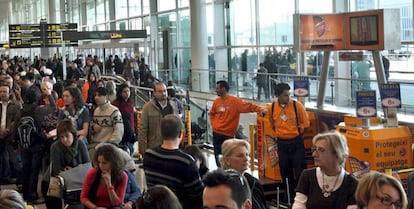What is a state of alarm and what will the Spanish government be able to do?
The measures that will go into effect from tomorrow will allow the executive to requisition all kinds of assets and intervene to ensure essential items are available


Spanish Prime Minister Pedro Sánchez announced on Friday that the Cabinet would meet tomorrow and approve the implementation of a state of alarm in the country, for only the second time since Spain returned to democracy in the late 1970s.
Article 116 of the Spanish Constitution describes three legal categories for emergency situations: state of alarm, state of emergency and state of siege (in Spanish: estado de alarma, estado de excepción and estado de sitio).
The only other time Spain declared a state of alarm was in 2010 during a wildcat strike by air-traffic controllers
The head of the executive has announced the adoption of this exceptional measure for a period of 15 days, and it is aimed at combatting the spread of coronavirus infections among the population. Should the government opt to extend the time period, it will need the approval of the lower house of parliament, the Congress of Deputies.
But what exactly is the state of alarm? Under the Spanish Constitution, once it has been activated the government can:
- Limit the circulation or presence of people or vehicles at determined times or in determined places, or oblige them to comply with certain requirements.
- Temporarily requisition all kinds of assets and impose mandatory services.
- Temporarily take over and occupy industries, factories, workshops, operations or commercial premises of any kind, with the exception of private households, informing the relevant ministry of such actions.
- Limit or ration the use of services or the consumption of essential items.
- Issue the necessary orders to ensure supply for the markets and the functioning of the services of production affected by article (4).
What’s more, the state of alarm works in a similar way to Article 155 of the Constitution, which allows the central government to suspend a region’s devolved powers. All civil authorities, regional and local police forces and other civil servants are placed under the orders of the competent authority as per the decree. The central government is able to require “extraordinary services,” according to the law.
The government can implement a state of alarm should there be “serious alterations to normality.” Among the cited situations is a health crisis such as an epidemic, although the coronavirus situation has now been classed as a pandemic.
The conditions for a state of alarm are:
- Catastrophes, disasters or public misfortunes, such as earthquakes, floods, urban or forest fires and major accidents.
- Health crises, such as epidemics and situations of serious contamination.
- The paralyzation of essential public services for the community [...].
- Situations of shortages of essential items.
The first and only time that a state of alarm was declared since Spain returned to democracy in the late 1970s was in 2010, when air-traffic controllers staged a wildcat strike, causing travel chaos.
English version by Simon Hunter.
Tu suscripción se está usando en otro dispositivo
¿Quieres añadir otro usuario a tu suscripción?
Si continúas leyendo en este dispositivo, no se podrá leer en el otro.
FlechaTu suscripción se está usando en otro dispositivo y solo puedes acceder a EL PAÍS desde un dispositivo a la vez.
Si quieres compartir tu cuenta, cambia tu suscripción a la modalidad Premium, así podrás añadir otro usuario. Cada uno accederá con su propia cuenta de email, lo que os permitirá personalizar vuestra experiencia en EL PAÍS.
¿Tienes una suscripción de empresa? Accede aquí para contratar más cuentas.
En el caso de no saber quién está usando tu cuenta, te recomendamos cambiar tu contraseña aquí.
Si decides continuar compartiendo tu cuenta, este mensaje se mostrará en tu dispositivo y en el de la otra persona que está usando tu cuenta de forma indefinida, afectando a tu experiencia de lectura. Puedes consultar aquí los términos y condiciones de la suscripción digital.
More information
Últimas noticias
There is as much life left to discover on planet Earth as that which is already known
Dozens presumed dead, around 100 injured in fire at Swiss Alps bar during New Year’s celebration
Is porn for women different from conventional porn? We spoke to those who make it
Cartagena de Indias is sinking: What can the city do to mitigate it?
Most viewed
- Reinhard Genzel, Nobel laureate in physics: ‘One-minute videos will never give you the truth’
- David King, chemist: ‘There are scientists studying how to cool the planet; nobody should stop these experiments from happening’
- Oona Chaplin: ‘I told James Cameron that I was living in a treehouse and starting a permaculture project with a friend’
- Sinaloa Cartel war is taking its toll on Los Chapitos
- The Interoceanic Train, the Mexican alternative to the Panama Canal










































